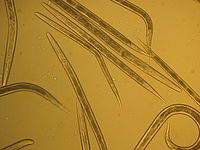- Panagrellus redivivus
-
Panagrellus redivivus 
Observation of Panagrellus redivivus on a Zeiss microscope stage Scientific classification Kingdom: Animalia Phylum: Nematoda Class: Secernentea Order: Rhabditida Family: Panagrolaimidae Genus: Panagrellus Species: P. redivivus Binomial name Panagrellus redivivus
L.The free-living nematode Panagrellus redivivus (Sour paste nematode) is known to many aquarium enthusiasts and fishkeepers as the microworm. It is a tiny roundworm used as the first food for minuscule newly-hatched fish, such as the popular pet fish betta. The microworm is widely used in aquaculture as food for a variety of fish and crustacean species.
The microworm is about 50 micrometers in diameter and just over 1 millimeter in length, barely visible to the naked eye. It is easily cultured at home on a substrate of flour or porridge.
The microworm has been used in genetic analysis studies, but not nearly as universally as its relative, Caenorhabditis elegans.
Instructions for Culturing Microworms
Many fish keepers culture the microworm at home for their fry. There are many different ways to culture microworms. Some use a slice of white bread or oatmeal.
Culturing Temperature Should be: Room Temperature to 80 degrees Fahrenheit.
Life Span: Micro Worms generally live 20– 25 days and start reproducing at three days of age, bearing up to 40 live young a day.
Size: 1/16”
Medium Base/ Bedding: Oatmeal, cooked according to directions is recommended for best results. After it has cooked, add another additional portion of oats to thicken the medium into a paste. Place the oatmeal into a covered container and place it in the refrigerator overnight to cool and harden. By morning you should be able to cut the mixture into cubes and place them evenly to fit into the bottom of your culturing container.
Harvesting: Gather the worms that are crawling up the sides of your container with a stir stick or cotton swab and dip them into a small portion cup half filled with clean water. Gently stir to mix the worms and water. Using an eye dropper or pipette, feed the worms to your fry.
Sub-culturing: It's best to start a new culture every 2–3 weeks. Prepare your new medium and add a part of your old culture to the new one.
Notes of Advice: Because the worms are so tiny, a drop of these nematodes goes a long way. Do not overfeed small fry because the water will go bad very rapidly.
Your culture will eventually become watery. If it gets too watery, start a new culture.
If your culture starts to smell bad, immediately start a new one.
When using brewer's yeast to begin your culture, use it sparingly. If too much yeast is used, an overwhelming amount of carbon dioxide will be created which can suffocate your worms if there isn't enough air circulation within your culturing container, so make sure that you have punctured tiny holes in your culturing container.
Since these worms will climb the sides of the container, it's always best to place newspaper or paper towels on the bottom surface of their containers because these worms are known to escape through the air holes and onto the surface where they're being kept. This will protect your table or shelf.
External links
Further reading
- Schlechtriem, C., M. Ricci, U. Focken and K. Becker. (2004). The suitability of the free-living nematode Panagrellus redivivus as live food for first-feeding fish larvae. Journal of Applied Ichthyology 20(3): 161.
- Kovaleva, E.S. et al. (2003). Panagrellus redivivus as a molecular model for cyst nematodes. Journal of Nematology 35(3): 348.
- Sautter J., Kaiser H., Focken U.,Becker K. (2007) "Panagrellus redivivus (Linné) as a live food organism in the early rearing of the catfish Synodontis petricola (Matthes)" Aquaculture Research, 2007, 38 (6) : 653-659
Categories:- Nematodes
- Pet foods
Wikimedia Foundation. 2010.
